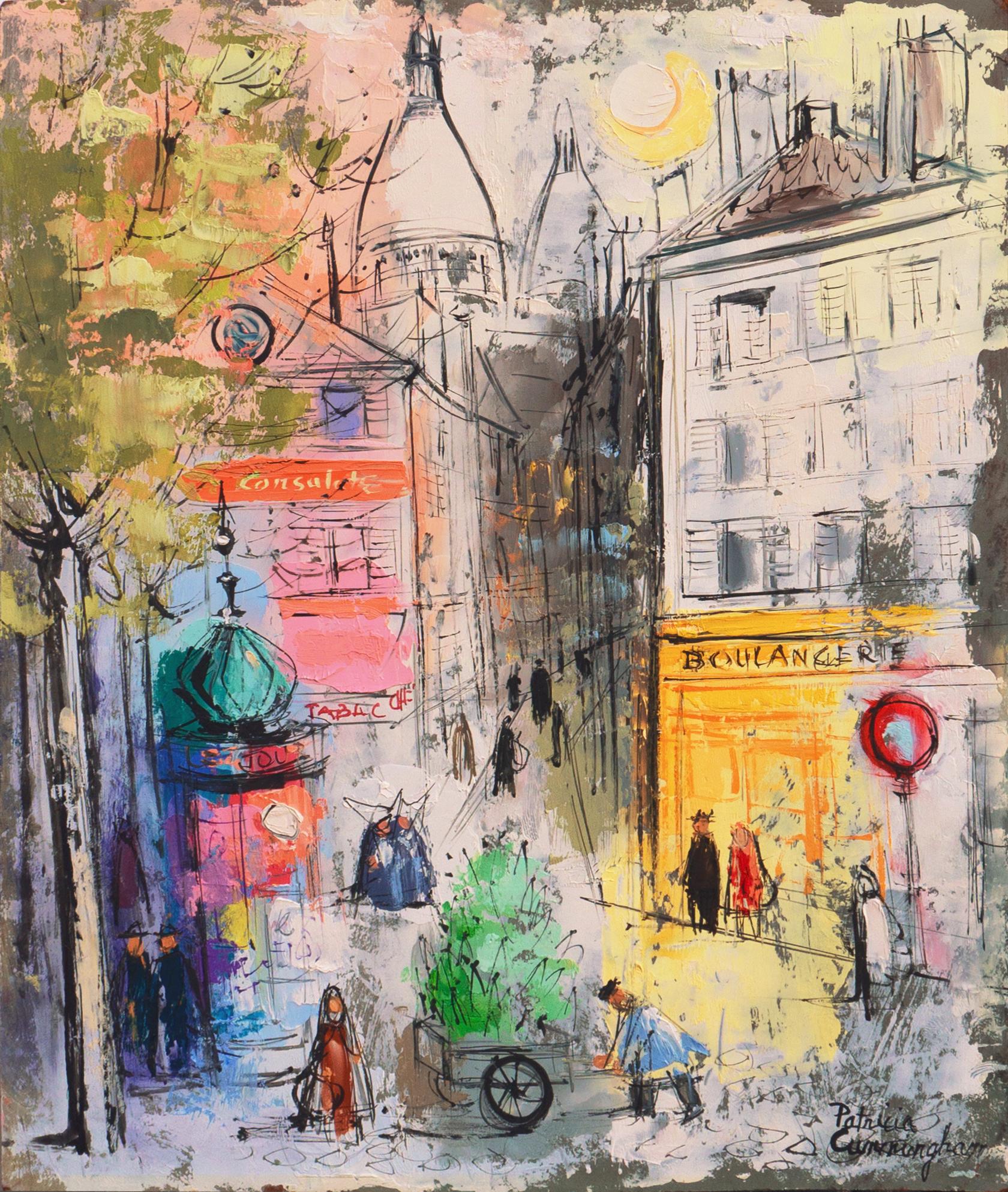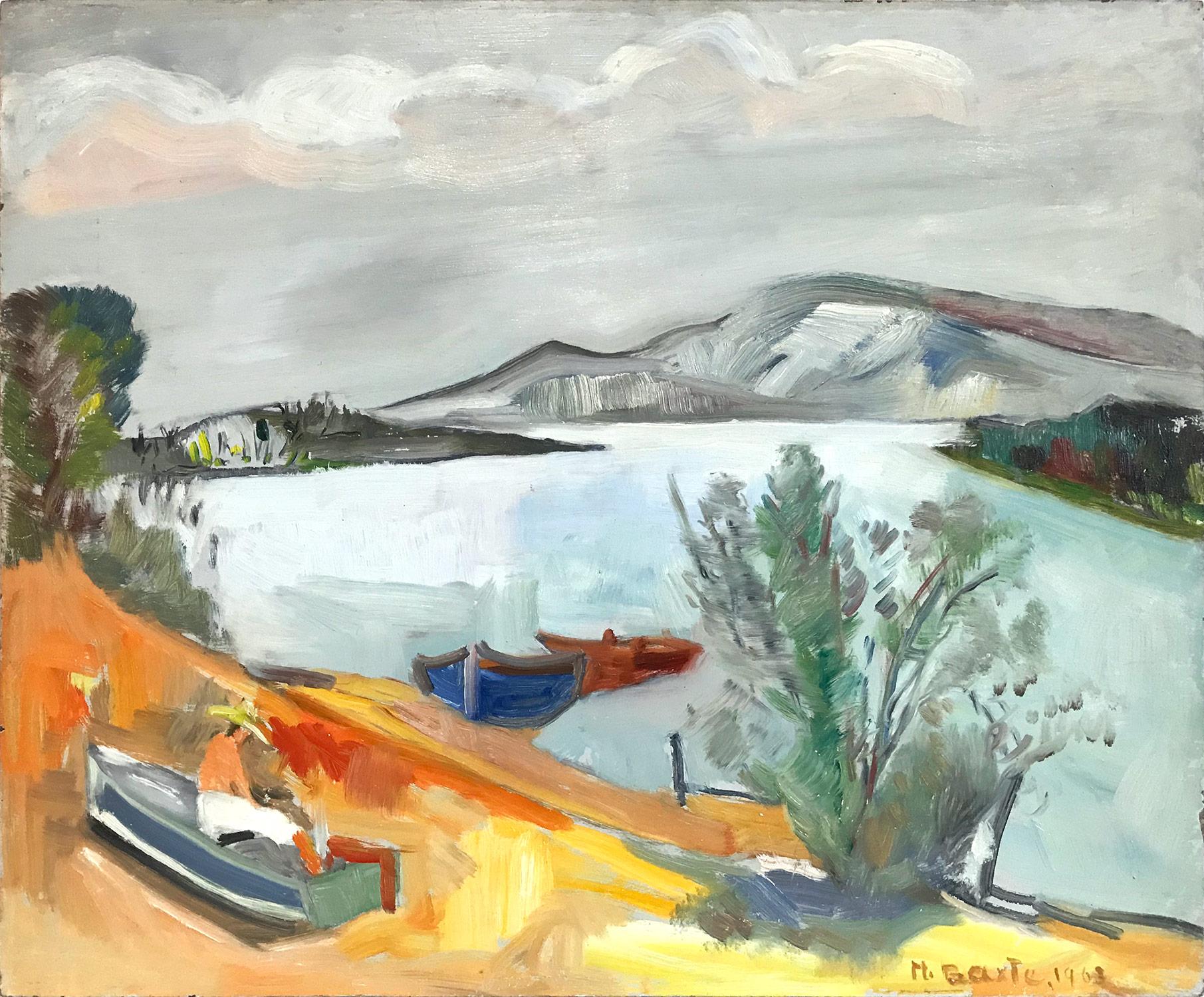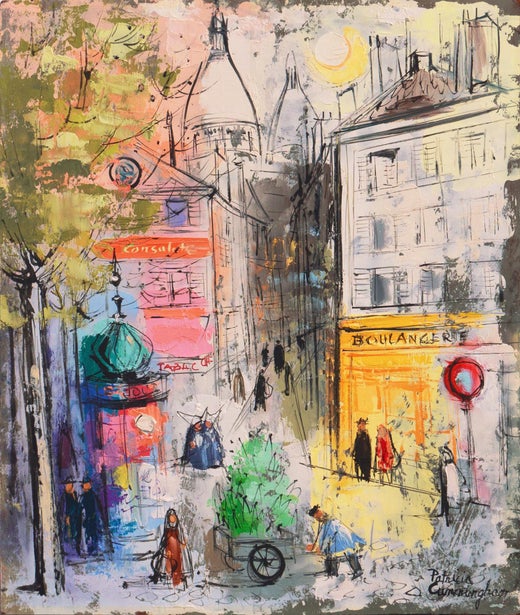Patricia Stanley Cunningham'Nuns at Notre-Dame', Paris, Munich, Woman Modernist, AIC, Smithsonian, CarmelCirca 1965
Circa 1965
About the Item
- Creator:Patricia Stanley Cunningham (1907 - 1984)
- Creation Year:Circa 1965
- Dimensions:Height: 17.5 in (44.45 cm)Width: 14.25 in (36.2 cm)Depth: 0.13 in (3.31 mm)
- Medium:
- Movement & Style:
- Period:
- Condition:minor toning, minor corner bumping; unframed.
- Gallery Location:Santa Cruz, CA
- Reference Number:1stDibs: LU34410580712
Patricia Stanley Cunningham
Patricia Stanley Cunningham first studied at the University of California, Berkeley and subsequently, under Hans Hofmann in Munich and with André Lhote in Paris. While in Paris in 1930, she married a classmate from UC, John Cunningham. Settling on the Monterey Peninsula after returning from Europe, Cunningham joined the Carmel Art Institute, the Southwest Artists and the Society of Western Artists. She was the first woman to serve as president of the Carmel Art Association. Cunningham was both a teacher at Mills College in Oakland and the University of California, Berkeley as well as a muralist and easel painter for the WPA Federal Art Project. In 1959, the Cunninghams founded the local chapter of the American Federation of Arts, which became the Museum of Monterey. Cunningham exhibited widely and with success, including at the “1940 Golden Gate International Exposition”, Gump's Gallery (San Francisco), Salt Lake City Museum, Carmel Art Association and Portland Art Museum (Oregon) among others. Her work can be found in collections throughout the country, including the Smithsonian, the Museum of Monterey, Art Institute of Chicago and the Spencer Museum of Art.
- ShippingRetrieving quote...Ships From: Santa Cruz, CA
- Return PolicyA return for this item may be initiated within 3 days of delivery.
- 'Montmartre, Place du Tertre', Paris, Woman Modernist, AIC, Smithsonian, CarmelBy Patricia Stanley CunninghamLocated in Santa Cruz, CASigned lower right, 'Patricia Cunningham' for Patricia Stanley Cunningham (American, 1907-1984) and painted circa 1965. The first woman to serve as president of the Carmel Art Assoc...Category
1960s Modern Landscape Paintings
MaterialsOil, Masonite
- 'Beneath the Stars', Lovers, Moghul, Isfahan, Chouinard, LACMA, Dallas MuseumBy Leon D'UsseauLocated in Santa Cruz, CASigned lower right, 'Dusso' for Leon D'Usseau, Jr. (American, 1918-1991) and painted circa 1965. A substantial oil painting showing two lovers reclining in a barge on a stream before a Persian palace crowned with domes and minarets; the pair elegantly dressed, with the young woman bejeweled and the young man playing a lute. Born in Los Angeles, Leon D'Usseau began training under the guidance of his father, who was among the earliest fine art film directors in Hollywood. At the age of twelve, he was drawing seriously and, at fifteen, he received a working scholarship at Chouinard School of Art where he studied under Merrill Gage and Alexander Archipenko and also taught a line-drawing class. Adopting the anglicized brush-name of Dusso, he exhibited widely and with success including at the Los Angeles County Museum of Art (1937-40), the California Palace Legion of Honor (1941), the Metropolitan Museum of Art (1942), the Laguna Festival of Arts, Los Angeles Artists Association (1945), the California Watercolor Society (1946) and the Audubon Association (1945). Leon Dusso...Category
1960s Figurative Paintings
MaterialsMasonite, Ink, Oil
- 'Dawn, Fishermen on Hermosa Beach' Los Angeles, Early California Modernist OilBy Thomas NashLocated in Santa Cruz, CASigned lower right, 'Thomas Nash' and painted circa 1900; additionally, signed and titled verso 'Hermosa Beach, Drawing in the Fish Net'. A turn of the ...Category
1910s Modern Landscape Paintings
MaterialsCanvas, Oil, Board
- 'Young Venetian Woman', Paris, Post Impressionist Figural, La VenezianaLocated in Santa Cruz, CASigned lower right, 'Janus' for Ian Janus (Dutch-Italian, born 1919) and painted circa 1955. A study of a beautiful young woman shown posed in the foreground with a distant evening ...Category
1950s Modern Figurative Paintings
MaterialsCanvas, Acrylic
- 'Notre Dame & the Left Bank', Paris, Post Impressionist oil, CharlottenborgBy Victor IsbrandLocated in Santa Cruz, CASigned lower left, 'V. Isbrand' for Victor Isbrand (Danish, 1897-1989), titled 'Paris' and painted circa 1965. Bearing 1965 exhibition label, verso, on stretcher bar. Precocious as...Category
1960s Post-Impressionist Landscape Paintings
MaterialsCanvas, Oil
- 'Young Woman with Doves', AIC, Salon d'Automne, Paris, Art DecoBy Nura UlreichLocated in Santa Cruz, CAA view of a landscape with a young woman shown seated and bathing her bare foot in a pool of water with white doves flying in a clouded, blue sky. Signed verso 'Nura' for Nura Wood...Category
1930s Surrealist Figurative Paintings
MaterialsOil, Illustration Board
- Victor, Colorado, 1940s Modernist Mountain Landscape with Town, Mining TownBy Martyl Suzanne Schweig LangsdorfLocated in Denver, CO'Victor, Colorado', 1942 oil painting on masonite by Martyl Suzanne Schweig (1918-2013). This classic Colorado landscape was painted overlooking a ghost town with the Rocky Mountains visible across the background, completed in rich tones of green, gold, and brown. This painting was completed on a trip with fellow artist, Adolph Dehn...Category
1940s American Modern Landscape Paintings
MaterialsMasonite, Oil
- Trastevere FountainLocated in Milford, NHA nice impressionist oil on masonite city scene with a young crowd in Rome, Italy, probably the Fontana del Prigione, illegibly signed lower right, title inscribed on verso “Trastev...Category
1950s Impressionist Figurative Paintings
MaterialsOil, Masonite
- "Summer at the Lake" - Mid Century Figurative LandscapeBy Grace B. OlsonLocated in Soquel, CAMid-century figurative landscape painting of people enjoying the summertime at a rustic cabin near a mountain lake by Santa Cruz, California artist Grace B. Olson (American, 1889-198...Category
1960s American Impressionist Landscape Paintings
MaterialsMasonite, Oil
- "Landscape Scene of Mexican Villagers" Expressionistic Oil Painting on MasoniteBy Michael BaxteLocated in New York, NYA strong modernist oil painting depicted in 1971 by Russian painter Michael Baxte. Mostly known for his abstracted figures on canvas or street scenes, this piece is a wonderful representation of his landscape paintings, with expressive use of color, shape, and form. Later in his career, Baxte explores Expressionism, infusing both European and North American stylistic trends. This piece is from later in his career, but we can feel this underlying style throughout. Art measures 18 x 21.75 inches Michael Posner Baxte was born in 1890 in the small town of Staroselje Belarus, Russia. For the first half of the 19th century it was a center of the Chabad movement of Hasidic Jews, but this group was gone by the middle of the 19th century. By the time the Baxte family immigrated to the United States at the beginning of the 20th century, the Jewish population numbered only on the hundreds. The native language of the Baxte family was Yiddish. It is likely that the death of Michael Baxte’s father triggered the family’s immigration. Three older brothers arrived in New York between 1903 and 1905. Michael and his mother, Rebecca, arrived in 1907. By 1910 Michael, his mother, and brother, Joseph, were living in New Orleans and may have spent some time on a Louisiana plantation. Around 1912, Michael Baxte returned to Europe to study the violin. In 1914 he, his mother, and Joseph moved to New York City. Meanwhile, in Algeria, a talented young woman painter, Violette Mege, was making history. Since for the first time, a woman won the prestigious Beaux Art competition in Algeria. At first, the awards committee denied her the prize but, with French government intervention, Mege eventually prevailed. She won again 3 years later and, in 1916, used the scholarship to visit the United States of America. When Violette came to New York, she met Baxte, who was, by then, an accomplished violinist, teacher, and composer. Baxte’s compositions were performed at the Tokyo Imperial Theater, and in 1922 he was listed in the American Jewish Yearbook as one of the prominent members of the American Jewish community. As a music teacher he encouraged individual expression. Baxte stated, “No pupil should ever be forced into imitation of the teacher. Art is a personal experience, and the teacher’s truest aim must be to awaken this light of personality through the patient light of science.” By 1920 Michael Baxte and Violette Mege were living together in Manhattan. Although they claimed to be living as husband and wife, it seems that their marriage did not become official until 1928. On their “unofficial” honeymoon around 1917, in Algiers, Baxte confided to her his ambition to paint. There and later in New Mexico where the wonderful steeped sunlight approximates the coloring of Algiers, she taught him his heart’s desire. He never had any other teacher. She never had any other pupil. For ten years she devoted all her time, energy, and ambition to teaching, encouraging, inspiring him. Then in 1928, their mutual strivings were rewarded, as his works were being chosen as one of the two winners in the Dudensing National Competition for American Painters. Out of 150 artists from across the country participated in the Dudensing, and Michael Posner Baxte and, Robert Fawcett, were the winners. In his 1924 naturalization application, he indicated that he was sometimes known as “Michael Posner Baxte.” One of the witnesses to his application was Bernard Karfiol, a Jewish American artist. That’s when Michael may...Category
1960s Expressionist Landscape Paintings
MaterialsMasonite, Oil
- "Landscape Scene of Fisherman by Lake" Expressionistic Oil Painting on MasoniteBy Michael BaxteLocated in New York, NYA strong modernist oil painting depicted in 1963 by Russian painter Michael Baxte. Mostly known for his abstracted figures on canvas or street scenes, this piece is a wonderful representation of his figures in water landscapes with expressive use of color, shape, and form. Later in his career, Baxte explores Expressionism, infusing both European and North American stylistic trends. This piece is from later in his career, but we can feel this underlying style throughout. Art measures 18 x 21.75 inches Michael Posner Baxte was born in 1890 in the small town of Staroselje Belarus, Russia. For the first half of the 19th century it was a center of the Chabad movement of Hasidic Jews, but this group was gone by the middle of the 19th century. By the time the Baxte family immigrated to the United States at the beginning of the 20th century, the Jewish population numbered only on the hundreds. The native language of the Baxte family was Yiddish. It is likely that the death of Michael Baxte’s father triggered the family’s immigration. Three older brothers arrived in New York between 1903 and 1905. Michael and his mother, Rebecca, arrived in 1907. By 1910 Michael, his mother, and brother, Joseph, were living in New Orleans and may have spent some time on a Louisiana plantation. Around 1912, Michael Baxte returned to Europe to study the violin. In 1914 he, his mother, and Joseph moved to New York City. Meanwhile, in Algeria, a talented young woman painter, Violette Mege, was making history. Since for the first time, a woman won the prestigious Beaux Art competition in Algeria. At first, the awards committee denied her the prize but, with French government intervention, Mege eventually prevailed. She won again 3 years later and, in 1916, used the scholarship to visit the United States of America. When Violette came to New York, she met Baxte, who was, by then, an accomplished violinist, teacher, and composer. Baxte’s compositions were performed at the Tokyo Imperial Theater, and in 1922 he was listed in the American Jewish Yearbook as one of the prominent members of the American Jewish community. As a music teacher he encouraged individual expression. Baxte stated, “No pupil should ever be forced into imitation of the teacher. Art is a personal experience, and the teacher’s truest aim must be to awaken this light of personality through the patient light of science.” By 1920 Michael Baxte and Violette Mege were living together in Manhattan. Although they claimed to be living as husband and wife, it seems that their marriage did not become official until 1928. On their “unofficial” honeymoon around 1917, in Algiers, Baxte confided to her his ambition to paint. There and later in New Mexico where the wonderful steeped sunlight approximates the coloring of Algiers, she taught him his heart’s desire. He never had any other teacher. She never had any other pupil. For ten years she devoted all her time, energy, and ambition to teaching, encouraging, inspiring him. Then in 1928, their mutual strivings were rewarded, as his works were being chosen as one of the two winners in the Dudensing National Competition for American Painters. Out of 150 artists from across the country participated in the Dudensing, and Michael Posner Baxte and, Robert Fawcett, were the winners. In his 1924 naturalization application, he indicated that he was sometimes known as “Michael Posner Baxte.” One of the witnesses to his application was Bernard Karfiol, a Jewish American artist. That’s when Michael may...Category
1960s Expressionist Landscape Paintings
MaterialsMasonite, Oil
- 1940s Southwestern Figurative Landscape -- Pueblo Village New MexicoBy William FratesLocated in Soquel, CAGorgeous 1940s New Mexico village scene with small figures going about daily life among adobe buildings that are iconic of the Southwest, by William “Will” Frates (American, 1896-1969). Signed "Will FRATES" in the lower right corner. Titled "New Mexico Village" and Will Frates" on verso in pencil. Unframed. Image size: 24"H x 29.5"W. William Frates...Category
1940s American Impressionist Landscape Paintings
MaterialsOil, Fiberboard, Masonite





